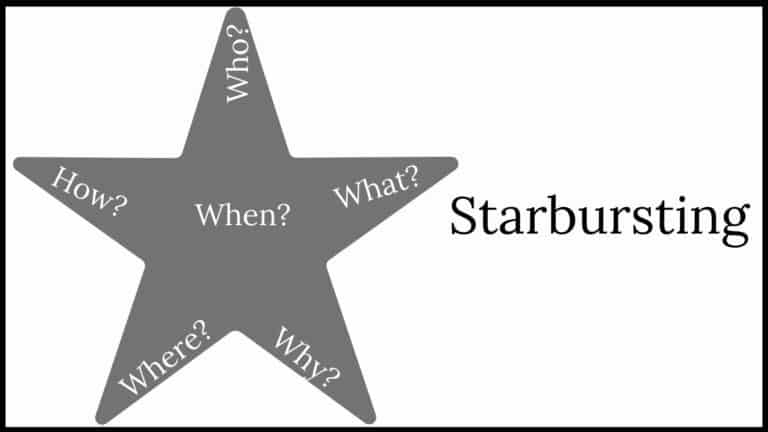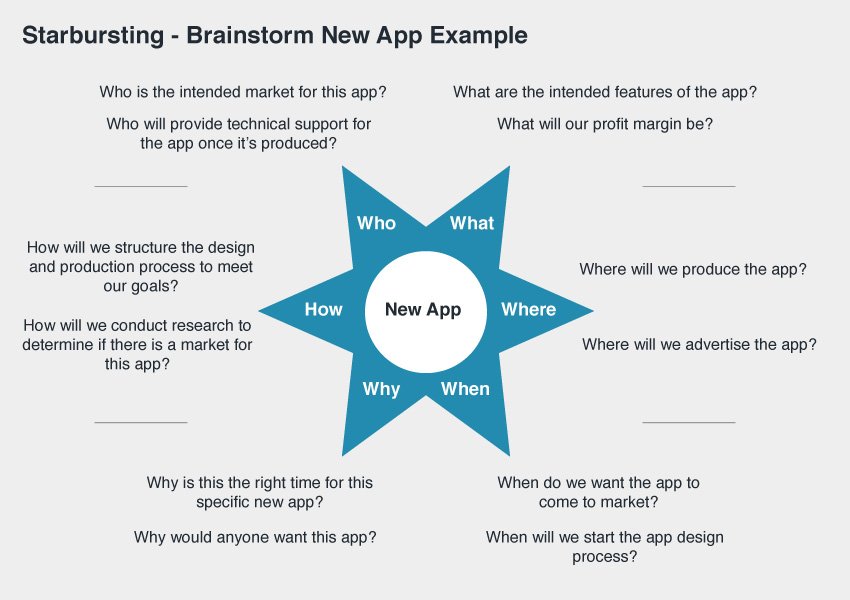The term, “starbursting” comes with a ton of different ideas. For a lot of folks, this term is in a way connected with astronomy or astrologers. Others think about it in literal terms; a star exploding. And in a weird kind of way, I can’t shake off the feeling that you somehow fall into one of these categories; especially if this is your first encounter. Well, starbursting has a lot in common with business than it has with astronomy; even though there’s a star factor in the picture. So what exactly does it mean to starburst? How does starbursting affect your business or company?
Without further ado let’s find out…
Starbursting: Overviewf
If you’re an entrepreneur (or work for one), you’ve probably said or encountered something along these lines:
Your team enters into brainstorming mode almost immediately. Donald feels the product should be yellow, Maggi likes the concept of a Bluetooth widget, and Debb is looking forward to designing environmentally friendly packaging.
However, before diving into ideation, design, and production, it’s generally a good idea to ask a few questions to get a better understanding of the new solution’s vision. After all, something created just for the pleasure of the production crew is unlikely to meet the demands, interests, or preferences of a wider audience or client base. It’s also unlikely to stay within budget.
It’s simple to just ask questions. “Shouldn’t we run some focus groups first before committing to yet another feature?” “Will we get a bonus for developing this, because it isn’t on our list of objectives for the year?” “Didn’t our competitor create a comparable widget last year that failed miserably?”
Random queries, on the other hand, yield random answers. “Perhaps,” “No,” or “Yes, it differed from our previous product design because…”
Basically, the end result is a jumble of data that is unlikely to aid decision-making or define the project’s vision, purpose, or methodology.
This is where “starbursting” comes into play.
What Is Starburst and How Does It Work?
Starbursting is a brainstorming technique in which team members are encouraged to start their creative juices flowing by asking questions rather than delivering immediate replies. It’s helpful when you’re brainstorming new product ideas, services, or feature sets that your team might wish to pursue. It can also be used in a variety of conceptual brainstorming situations.
It’s a straightforward operation to burst stars. It begins with a star and grows from there, as one might expect. The product, service, or concept to be addressed is in the center of the star. The basic questions are identified on each of the six points of the star: who, what, where, why, when, and how.
A starbursting meeting is designed to produce a variety of questions rather than simply one question for each point of the star. The group gets to work answering the questions when they’ve been generated (typically 50 or more!). Taking this approach will help the group solve crucial issues and set the foundation for reasonable, focused planning and implementation by the end of the meeting.
Introduction to Starbursting: A subset of Brainstorming
We are all aware of the importance of brainstorming in the development and implementation of any concept.
It all boils down to obtaining as much information as possible regarding the new concept you’re developing. Starbursting is based on a similar concept; it aims to gather information about the concept or product, but doesn’t directly answer questions; instead, it collects them. The concept of starbursting aids us in making more informed decisions.
It’s natural for employees to be perplexed after the development of a new product or concept. But the next phase should involve asking the important stuff like;
- Is the product going to be a success?
- What about your rivals?
- What is the best way to proceed with the new concept?
- How will the new product schedule look like?
Questions like these set a whole lot of things into perspective, saving you a ton of money and stress. Employees gain a deeper understanding of the product/concept by asking these questions. This will, more often than not, aid the marketing process and spike sales in the end.
What is the Starbursting Technique, and how does it work?
Every endeavor begins with the formulation of an idea. Understanding all project-related elements and asking the right questions to evaluate the new idea is the most difficult challenge. While various brainstorming techniques are used to explore fresh ideas and solutions. The Starbursting technique investigates solutions by posing questions about them. It works in the same way as the Reverse Brainstorming technique.
The Starbursting approach is a strategy for asking questions that elucidate the various aspects of new ideas and their potential.
What is the intended market segment, for example? How are we going to market the product? And when is the best time to launch?
Six primary question groups are grouped in a star form in Starbursting. Like in the image above, these questions include the; Who? What? When? Where? Why? and How? They are the questions that are used to categorize these groups.
During the team meeting, each question group is discussed, and certain questions are assigned to each group. Answering the questions will provide you with a clear picture of the project or new idea. The facilitator should think about the following things to ensure that the starbursting approach is implemented successfully:
- A set of questions that are asked in a precise order.
- Questions that are pertinent to the subject or concept.
- Questions that are connected to the project or concept.
How Does Starbursting help Different Organizations?
No organization can flourish with a new concept if its members have doubts about it and the information available to them is unclear. As a result, it is critical to provide as much information as possible regarding the notion and to dispel any misconceptions they may have. The easiest method to dispel an individual’s doubt is to respond to their inquiries.
When a product or concept is being developed, it is recommended that a starburst session be held so that everyone involved can ask questions.
- What is the purpose of the product?
- What is the geographical area in mind?
- When will the product be available for purchase?
- What is the best way to deal with competitors?
- What are our plans for the post-launch processes?
- Who is a potential client?
- What will be the advantage to us?
- What method will we use to conduct the research?
These inquiries stem from your team’s eagerness to learn more about the new product or concept. When you have satisfactory answers to these questions, it is clear that your team’s concerns about the product/concept will be dispelled.
Furthermore, holding starbursting sessions will assist the team later on while they are working on the product/concept. When the team is free of doubts, they can work on the concept with utmost efficiency, and the odds of making a mistake become slimmer to none.
As a result, starbursting is tied to your team’s efficiency.
When you give your team the freedom to ask questions, they will think differently and more efficiently than they would otherwise.
Basically, when they take the time to ask questions, it’s always a plus when it’s time to work on your product/concept. In other words, I cannot overemphasize the value of starbursting, and enterprises of all sizes should consider it.
Along with the benefits of starbursting noted above, there are some drawbacks as well, so let’s have a look at those as well.
The Steps to Starburst
It’s time for the starbursting session after you’ve finished developing your product/concept. To get the most out of it, you must now do it effectively. Here’s how to make a perfect starburst;
- Bring your staff together and ask them to ask questions regarding the product or concept.
- Create a large star on the whiteboard and center the concept or product description within it.
- Once your team has completed the questions, place them one by one on the star’s tip.
- You can also write one-word questions on the star’s tip, such as who, what, why, how, and so on, and then ask your team to brainstorm questions related to the words written at the tip.
- At this point, don’t worry about answering them. Simply ask questions.
- It is recommended that you keep going until you have three questions for each of the star’s tips.
- Start answering the questions one by one after you’ve gathered all of them. Next to the questions on the tip, write their replies in brief form.
Disadvantages of Starbursting
Starbursting has a lot of advantages and appears to be virtually perfect, but it does have some drawbacks.
One of the major drawbacks is that certain questions may arise at a later stage that you do not want to answer. You’ll have to hold several meetings afterward, regardless of how productive your starbursting session was.
You will not find those starbursting sessions useful when conducting additional sessions for planning and other purposes.
To get the most out of your starbursting sessions, you’ll need to encourage your team to ask questions, which can be challenging at times.
However, starbursting is extremely effective for any organization and should be considered.
Let’s look at how you can do Starbursting like a pro now.
How to Use the Starburst Technique
The next stages will show the team how to use the starbursting process. The designer might just follow the steps below for personal or individual thinking. The discussion facilitator for company teams should lead the rest of the discussion members through it.
Step 1
Draw a six-point star on a large sheet of paper. Write your idea or project name in the middle of the star.
For instance, the corporation wants to develop a new mobile app for its online store. In the center of the paper, write the phrase “mobile application.”
Step 2
Write one of the main question groups at each point of the star: The Who? What? When? Where? Why? and How? These groupings will be discussed with your team in sequential order.
Step 3
Begin by brainstorming each type of question and writing them down on the star point that corresponds to them. At this point, concentrate on writing down the question rather than responding to it. The questions in a mobile application project are shown in the diagram below.
The Whos:
- Who will use this app?
- Exactly who will be involved in the project?
- Who are our main rivals?
The Whats:
- What will you call it?
- Exactly what is the pricing for the application?
- What is the project’s creative style?
The Hows:
- How would this application benefit your company?
- What methods will we use to promote it?
- How will we integrate it into our existing services?
The Wheres:
- Where will the application be sold?
- Where are you going to put ads?
- Exactly Where will the money come from?
The Whens:
- When will the app be available?
- When will we begin to develop?
- Exactly When will the advertising begin?
The Whys:
- Why are we making this app?
- What would pique people’s attention in this app?
- Why will it be able to outperform its competitors in the market
Using the Starbursting tool to investigate the questions.
Step 4
The team discusses the responses to each question at this point. The replies gathered help to form a clear picture of the product or concept. If there are a lot of questions, more meetings might be scheduled to go through all of the answers.
Example of a Starburst Session: Concentrated on a New App
The majority of the time, starbursting meetings concentrate on the specifics of a proposed project. As a result, the first questions posed are usually straightforward. Consider a company that is discussing the development of a new app. Many of the following questions may arise as a result of starburst:
- Who is the target audience for this app?
- What are the app’s primary functions?
- Where are we going to make the app?
- When do we want the app to be available for download?
- Why is now the best moment to launch this new app?
- To achieve our objectives, how will we structure the design and production process?
However, brilliance doesn’t end with these fundamental concerns. The participants are then invited to come up with a list of questions based on the key terms. Consider the following scenario:
- When the app is finished, who will provide technical support?
- What is our profit margin going to be?
- Where will the app be promoted?
- When will the app design process begin?
- Why would anyone want to use this application?
- How will we perform market research to see if this app has a market?
Starbursting can also be used to test out new ideas, philosophical directions, or possibilities. Simply place the subject you want to investigate in the center of the star and lead a group discussion. If you put the words “mobile-first” in the middle of the star, for example, you might get questions like:
- What does a typical mobile-first consumer look like?
- When customers search the web on their phones, what do they want to find?
- What are the benefits of a mobile-first strategy?
- When customers search on their smartphones, where do they go?
- When should we start thinking about mobile-first design?
- How could we persuade our clients to use a mobile platform?
As you can see, these inquiries have nothing to do with the manufacture of a product or service. Rather, they are linked to the broader question of whether and why a mobile-first strategy is appropriate for a specific company.
Managing Inquiries
It may be difficult to keep team members on target and focused because starbursting is an open-ended activity. Without proper facilitation, each question might quickly lead down a long and winding path.
Let’s return to the “let’s build a mobile app” starburst as an example. “Why can’t we hire new staff to build this app instead of piling more work on our existing development staff?” Ben might wonder as he examines the star’s “why” point.
Ben may have a valid point, and he certainly began his inquiry with the word “why.” Unfortunately, the answers to this question are likely to divert the team’s attention away from the topic at hand and into the murky waters of human resource decisions and corporate finances.
It will be up to the facilitator to decide how such questions will be handled. Attempting to address them will almost probably derail the conversation. Suppressing them, on the other hand, may result in a lack of participation in the process.
So for dealing with off-topic (but important) queries, the facilitator has a few options. He could make a separate list of such unrelated questions to be handled at a later date.
He/She could also ask team members to repeat the question in the context of the current topic. As a result, Ben’s query may be rephrased as “How can our team take on this new assignment without working overtime?”
People Management
For certain people who enjoy the sound of their own voices, starbursting, like most brainstorming approaches, can become a “bully pulpit.” Try one or more of the following techniques to ensure that every voice is heard and that no one voice dominates:
- To ensure that no one can “filibuster” the meeting, set a timer.
- Individuals who have not yet spoken should be called upon, and anyone may speak twice.
- As you work your way around the star, go around the room and ask each individual to come up with a question about the next point on the star. For example, Benny might ask a “who” question, then Donald might ask a “what” question, and so on.
- Rather than asking questions orally, give each participant 10 minutes to jot down one question for each point of the star. Then gather all of the questions and write them down.
- Conduct two distinct meetings, one to ask questions and the other to provide answers.
Time Management
You can spend as much time as you want on starbursting. The task at hand is to make certain that each question is asked and answered. Time management options include:
- Limiting the amount of time allotted to each step of the process (e.g., five minutes to brainstorm questions for each point of the star, three minutes to address each question, and so forth).
- Limiting the number of questions asked at each of the star’s points.
- Assigning six different working groups to discuss the questions (group A answers the Why questions while group B answer the How questions, etc.)
- Posting the starburst chart and questions in a public area and asking people to write and post potential answers on sticky notes over several days.
Starbursting Variations
Some corporations use starbursting to analyze institutional direction in addition to making decisions about new initiatives. Instagram used a similar technique to identify the major issues with mobile photography, according to an article on the 99U website.
They chose three to focus on after brainstorming a list of questions to consider. They were able to pinpoint the three most important issues related to mobile photography at the time after a lengthy discussion: “lackluster photos, lengthy upload times, and share-ability.”
After which, they created a set of actionable corporate statements based on their findings. These are paraphrased by 99U as follows:
- Vision – We want all of our user’s photos to upload to our app seamlessly, looking exceptionally beautiful, where they can all comment and share without any distractions.
- Statement of the Problem – Today, too many apps capture poor photos that fail to capture the essence of the photographer’s vision. It takes a long time to upload or text these photos, making it difficult to share them with friends and family.
- Method – Using our human-centered design process, we will discover our users’ ultimate needs. We will be able to continuously enhance our product using the lean methodology.
Of course, everyone knows how this story ends. Instagram was able to create one of the world’s most popular mobile photos sharing sites and apps, demonstrating how effective a process of deeper inquiry can be.
Keep These Important Points in Mind
Exploring ideas, possible products, and new business paths via starbursting is a beneficial tool. Team members produce questions to examine – and solve problems that are expected to develop – by starbursting.
To Summarize:
- Starbursting is a style of brainstorming that prioritizes questions before answers.
- It is conducted with the use of a six-sided star; each point is allocated one question (who, what, where, why, when, how).
- Participants generate questions starting with each question word.
- Multiple questions are generated for each question.
- Questions are handled by the group.
- Starbursting is more complicated than it appears, and it requires the assistance of a facilitator.
- It’s a good way to generate and consider ideas, but it’s not a good way to come up with a strategy.
What Are the 3 Things to Consider When Brainstorming?
The need for comprehensive, big-picture planning (advanced preparation) a sound methodology, and strong, active leadership throughout the process are 3 important factors to consider when brainstorming.
How Do You Brainstorm Questions?
The most important factors to consider when you want to brainstorm questions in starbursting include the facilitator’s ability to manage people, time, and questions.
What Is the Secret to Successful Brainstorming?
COMPLETELY DEFINE THE PROBLEM: Brainstorming works best when it’s aiming to solve a specific problem rather than just coming up with ideas. Before anyone begins to analyze, the problem should be written out and plainly presented.
How Do You Use the Starbursting Technique?
Starbursting: How to Use It
- Draw a star with six points. Draw a six-pointed star on a whiteboard or a large piece of paper to start your starbursting session.
- Include the questions. On each point of the star, write one of the following question words:
- Brainstorm questions.
- Talk about the possible answers.
What Are the Benefits of Starbursting?
There are many benefits to starbursting.
- Most importantly, it gives the exercise of coming up with ideas some structure.
- It helps you keep track of everything and makes sure everyone is involved. It can be used for many things, from coming up with ideas to making the detailed plans for a project.








